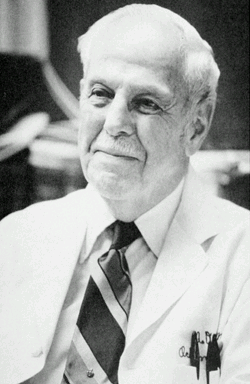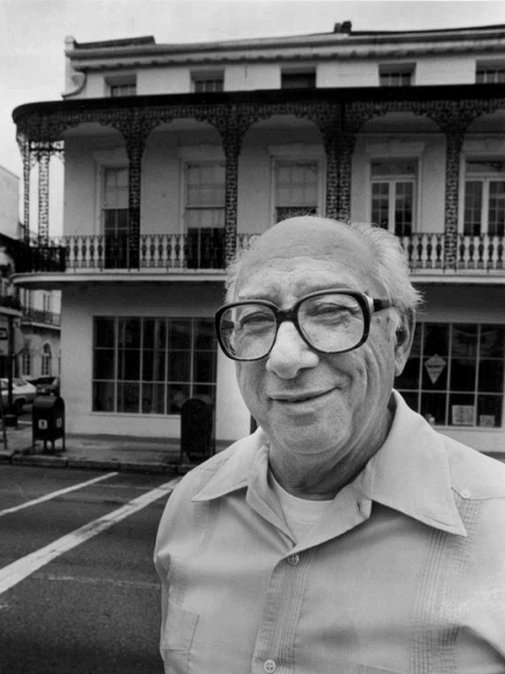|
Today in New Orleans History |
|
|
September 24


 To receive an update for each day in New Orleans history,
join our facebook page - Today in New
Orleans History.
 To receive an update for each day in New Orleans
history, join our facebook page
- Today in New Orleans History
Cosimo Matassa’s J&M Recording Studio September 24, 2010 Photo from the Louisiana Endowment for the Humanities Born
in New Orleans on April 13, 1926, Cosimo Matassa is the recording
engineer and studio owner responsible for nationally renowned R&B and rock and
roll recordings at his New Orleans studios. Matassa described himself simply as a "sound engineer" in a July 19,
1981 Times-Picayune article written by John Pope. He went on to say that his formula for success was not complicated
in any way..."Do it live or do it over again until it was done right". He did it right for hundreds of young
unknown musicians including Ray Charles, Fats Domino, Mac Rebbenack (Dr. John), Mickey Gilly and so many more from 1945 through
1968 in his studio in the Quarter and later in the Central Business District. J&M recorded Alan Toussaint's first
record, "The Wild Side of New Orleans" which was released by RCA Victor. He recorded Aaron Neville's "Tell
it Like it Is", Robert Parker's "Barefootin'", and Little Richard's "Tutti Frutti" in 1956 -- a recording
which has been acclaimed as a seminal Rock and Roll song. Cosimo Matassa was an 18 year-old second-year
chemistry major at Tulane during World War II who quit school because he thought he would be drafted into military service.
But the war soon ended and he drifted into the music industry by taking a job involvling juke boxes which led to an interest
in records which led to invlovement with his father's J&M Music Shop on the corner of Rampart and Dumaine which evolved
into his first studio in 1945 in a back room of the store which was named for his dad, John Matassa and his partner
Joe Mancuso. In 1955, Cosimo moved to the larger Cosimo Recording Studio in the CBD.
Here, as engineer and proprietor, he was crucial to the development of the R&B, rock and soul sound of the 1950s and
1960s, often working with producers Dave Bartholomew and Allen Toussaint. He recorded hits by Fats Domino’s "The
Fat Man" (another contender for the first rock and roll record), Little Richard's "Tutti
Frutti", and records by Ray Charles, Lee Dorsey, Dr John, Smiley Lewis, Bobby Mitchell,
Tommy Ridgley, the Spiders and many others. He was responsible for developing what became known as the "New Orleans
Sound", with strong drums, heavy guitar and bass, heavy piano, light horn sound and a strong vocal
lead. In the late 1950s and early 1960s, Matassa also managed the successful white New Orleans rock and roll performer Jimmy
Clanton. He retired from the music business
in the 1980s to manage the family's food store, Matassa's Market in the French Quarter. In December 1999, J&M Recording
Studio was designated as an historic landmark by the Orleans Parish Landmarks Commission.
In October 2007, Matassa was honored for his contributions to Louisiana music with induction into The Louisiana Music Hall
of Fame. On September 24, 2010, the Rock and Roll Hall of Fame and Museum designated Cosimo
Matassa’s original J&M Recording Studio as an historic Rock and Roll Landmark, one of 11 nationwide. The studio
is now a laundromat. Matassa was inducted into the Rock and Roll Hall of Fame during its 27th
annual ceremony on April 14, 2012. In 2013, he was inducted to the Blues Hall of Fame. Paul Franklin Dietzel (September 5, 1924 – September 24, 2013) was an American football player, coach, and college athletics administrator. He served as the head coach at Louisiana State University (1955–1961), the United States Military Academy (1962–1965), and the University of South Carolina (1966–1974), compiling a career record of 109–95–5. Dietzel's 1958 LSU team concluded an 11–0 season with a win over Clemson in the Sugar Bowl and was a consensus national champion. For his efforts that year, Dietzel was named the National Coach of the Year by both the American Football Coaches Association and the Football Writers Association of America. Dietzel also served as the athletic director at South Carolina (1966–1975), at Indiana University Bloomington (1977–1978), and at LSU (1978–1982). Hurricane Rita compounded the already growing problems post-Katrina as it makes landfall
just west of where Hurricane Katrina had landed. Brigador General Doug Pritt and the 41st
Brigade Combat Team of Oregon were designated as the head of Joint Task Force Rita, leading the multi-state National
Guard relief efforts in the aftermath of Hurricanes Katrina and Hurricane Rita. The official regionwide death toll
from Hurricane Katrina was upgraded to 1,080. Mississippi still had not officially increased its death toll by much, but
added 2 to the count. Thousands feared dead in Mississippi and Louisiana remain out of the official death toll. State-by-State
death tolls: Louisiana 841, Mississippi 220, Florida 14, Alabama 2, Georgia 2, Tennessee 1. On
September 24, 2005, Hurricane Rita did not breach the temporary repairs in the main part of the city, but the repair on
the Industrial Canal wall in the lower 9th ward was breached, allowing about 2 feet (0.61 m) of water back into the
area. Superdome Scheduled to Reopen Post-Katrina The NFL announced on February 5, 2006, that the Superdome would reopen
for the first time post-Katrina on September 24 when the Saints hosted the Atlanta Falcons.
Hurricane Flossy
originated from a tropical disturbance in the eastern Pacific Ocean and moved across Central America into the Gulf of Mexico
as a tropical depression on September 21, which became a tropical storm on September 22 and a hurricane on September 23.
The hurricane peaked with maximum sustained winds of 90 mph before it struck the central Gulf coast as a Category
1 hurricane on September 24, and evolved into an extratropical cyclone on September 25.
It was the first hurricane to affect oil refining in the Gulf of Mexico. The tropical cyclone led to flooding in New Orleans
(about 2.5 square miles were flooded as portions of the seawall were overtopped) and broke a drought across the eastern United
States.
Publisher & Mysterious Stranger Edward Austin Burke Dies The first Democrat to hold the office of Louisiana State Treasurer following
Reconstruction, Edward Austin Burke (or Burk) was born on September 13, 1839. He held that
office from 1878 to 1888. He later fled to Honduras after it was discovered that there were misappropriations
of state treasury funds. While in Honduras Burke became a major land owner and held government
positions within Honduras’ nationalized railway systems. He remained an exile untill his death nearly four decades
later on September 24, 1928. His entire life prior
to 1865 is a mystery, compounded by fabrications. He pretended to have been a Confederate major, he may also have
served in the Union Army—or in neither. He arrived in New Orleans as a common laborer after the war and as an
opportunist par excellence soon achieved prominence in the city's
Democratic party. He managed the Democratic state campaign in 1876, was the leading spokesman for Louisiana's
whites in Washington, D. C. after the war, and was active in negotiations which ended Reconstruction in 1877. In his
political career after Reconstruction he allied himself with the corrupt Louisiana State Lottery Company; was elected state
treasurer in 1878 (serving until 1888), and recognized to be the behind-the-scenes leader of state government during Gov.
Samuel D. McEnery's administration from 1879--1888. Regarding his newspaper career, Burke was managing editor of New Orleans Democrat from
1879 utnil 1881 which was owned by Burke and Lottery interests and
which merged with the Times to form the Times-Democrat in 1881 with Burke as publisher. He spearheaded the New Orleans World's
Industrial and Cotton Centennial Exposition (1884 -- 1885). In 1889 he was indicted for embezzlement in state bonds totaling over $1,000,000.
After fleeing to Honduras he successfully resisted extradition. Burke died on September 24, 1928 and was interred somewhere
in Honduras in 1928. Source: http://lahistory.org/site19.php
Jazzman Isidore John Barbarin is Born Born in New
Orleans on September 24, 1871, jazz cornet and alto horn player Isidore John Barbarin was a mainstay of the New
Orleans jazz scene in the decades around the turn of the 20th century. He learned to play the cornet at age 14, then
played in various New Orleans brass bands including the Onward Brass Band, the Excelsior Brass Band, and Papa Celestin's
Tuxedo Brass Band. He can be heard today in a 1945 Bunk Johnson and a 1946 Original Zenith Brass Band
recording. Barbarin died in New Orleans on June 12, 1960. He left a New Orleans musical
legacy; sons Paul, Louis, Lucien, and William as well as his grandson, Danny Barker.
|
|
|

To receive an update for each day in New Orleans history,
join our facebook page - Today in New
Orleans History.
Analytics |



